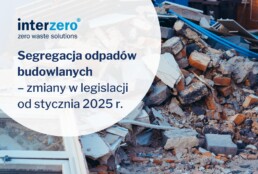
From January, changes in the way construction and demolition waste is separated
From 2025 onwards, segregation of construction and demolition waste at source will not be mandatory. The abolition of the obligation to segregate at source (which has not even taken effect yet) is provided for in the draft amendment to the Waste Act, which the Council of Ministers adopted during its meeting of 29 October 2024.
Abandonment of the obligation to separate construction and demolition waste at source
The most important provisions of the amendment are abolition of the obligation to segregate, i.e. separate collection of construction and demolition waste on site and defining responsibility for sorting out the waste fractions.
Each contractor generating construction and demolition waste will be required to segregate at least 6 fractions at the point of generation:
- wood waste,
- metal waste,
- glass waste,
- plastic waste,
- gypsum waste,
- mineral wastes, including concrete, bricks, tiles and ceramic materials and stones.
The draft amendment to the Waste Act was created in response to interpretative doubts and potential problems with the organisation and cost of selective reported by representatives of the construction industry. The previous version of the legislation, which was due to come into force on 1 January 2025, lacked a clear statement on whom the obligation to selectively collect and collect construction and demolition waste falls. The need to sort them for 6 fractions on site would also result in a sharp increase in the cost of exporting such waste, which in turn could contribute to its illegal dumping and dumping directly into the environment.
The waste generator will be able to have the waste segregated
According to the provisions of the Act amending the Waste Act, an entrepreneur generating construction and demolition waste will be able to hand them over to another authorised operator who will take over the obligation to separate them into a minimum of 6 fractions off-site generation. Importantly, the transfer of waste to another entity does not completely relieve the generator of construction and demolition waste of its responsibility to fulfil the segregation obligation. If this obligation is not fulfilled through the fault of the entity that has taken over the waste, both entities (generator and transferee) will be jointly and severally liable.
The new rules are due to come into force from 1 January 2025.
Handling of construction and demolition waste according to the hierarchy
In the explanatory memorandum of the bill, its authors emphasised the need for entrepreneurs to adhere to the so-called waste hierarchy:
providers of construction, demolition, renovation services (building contractors) are obliged to prevent waste.[i]
As a first step, therefore, measures should be taken to prevent construction and demolition waste. Selective waste collection should only take place when the materials in question are no longer reusable. The sorting itself, on the other hand, is intended to ensure suitability for preparation for reuse, recycling and other recovery. Regardless of where they are sorted (on-site or off-site), the individual fractions of construction and demolition waste should then be handed over to specialised entities for further management. For this purpose, it is often necessary to commission a professional collection of construction and demolition waste from a designated address offered by, among others, the waste collection company Interzero.
[i] https://orka.sejm.gov.pl/Druki10ka.nsf/0/A065E318FFC3BE21C1258BC70041F23F/%24File/766-uzasadnienie.docx